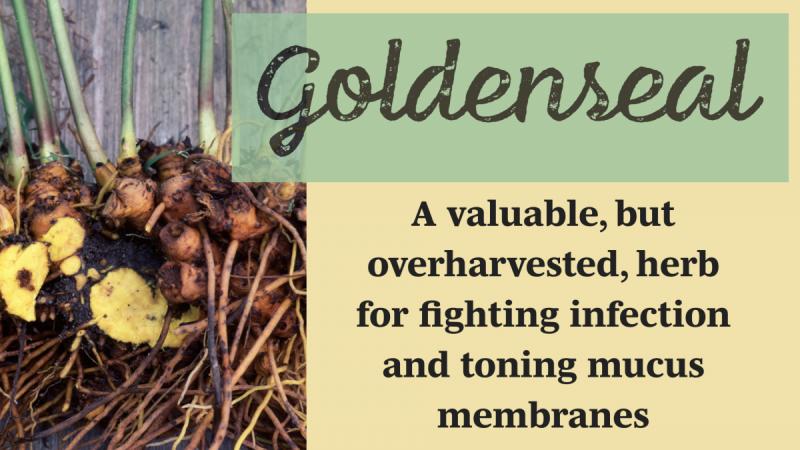
When I was young, my mom would apply goldenseal to the canker sores I was prone to. It helped, but oh, how I hated the taste of that nasty yellow powder! As I began to study herbalism in my late teens and early twenties, I came to appreciate this valuable herb more and I also became more tolerant of its bitter taste. In fact, I found that when I had a canker sore and an "acid stomach," I actually felt better if I sucked on a little goldenseal powder or took some of it as an extract.
Back in the 80s and 90s I used goldenseal for a lot of things. But, I don't use it as much anymore because it's been overharvested and has become endangered. This has also increased its cost. So it is best to use alternative remedies whenever possible. However, because it is still a useful remedy for many things, I'm going to share some information and interesting experiences with this popular herb.
Goldenseal, Berberine, and Infections
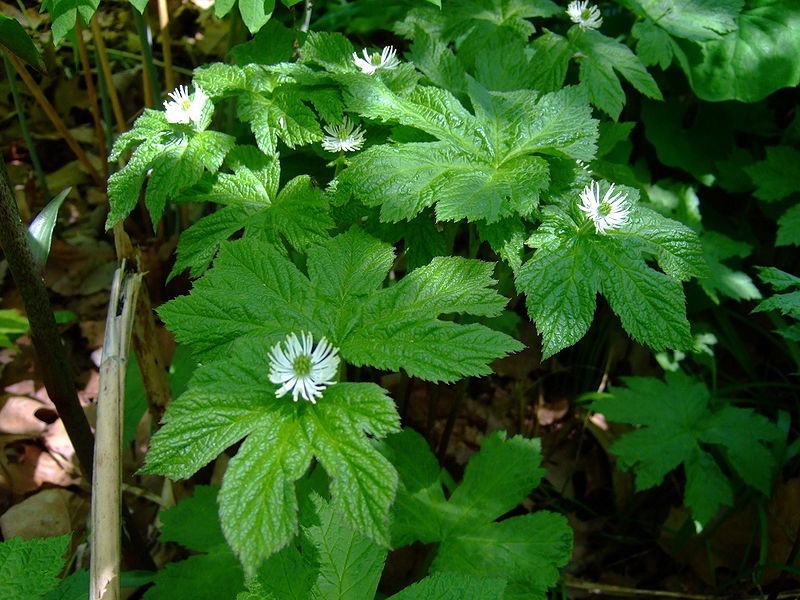 Goldenseal is one of a handful of herbs that contain a yellow alkaloid called berberine. There has been a lot of research done on the value of berberine which you can read about in The Amazing Benefits of Berberine. Berberine is an antibacterial and antifungal agent and herbs that contain this bright yellow alkaloid have been used around the world to treat infections. They've also been used to make yellow dyes.
Goldenseal is one of a handful of herbs that contain a yellow alkaloid called berberine. There has been a lot of research done on the value of berberine which you can read about in The Amazing Benefits of Berberine. Berberine is an antibacterial and antifungal agent and herbs that contain this bright yellow alkaloid have been used around the world to treat infections. They've also been used to make yellow dyes.
Back in the 1980s and 90s, one of the most popular herbal duos in the marketplace was goldenseal and echinacea. This combination was used as an antibiotic alternative and I found it valuable for sinus and urinary tract infections.
While it's still a powerful combination, because of its scarcity most everyone uses Oregon grape or other herbs with berberine in place of goldenseal. These alternatives are great substitutes that work just as well in most cases.
But, one particular infection I would still use goldenseal for is amebic dysentery (giardia). The plant is officially recognized as a remedy for this parasitic infection in several countries. It's the most common cause of diarrhea from drinking contaminated water. A good way to use goldenseal for this purpose would be to take two capsules of goldenseal or 60 drops of a tincture or extract along with one capsule of activated charcoal every four hours until symptoms cease.
An Interesting Experience with Goldenseal
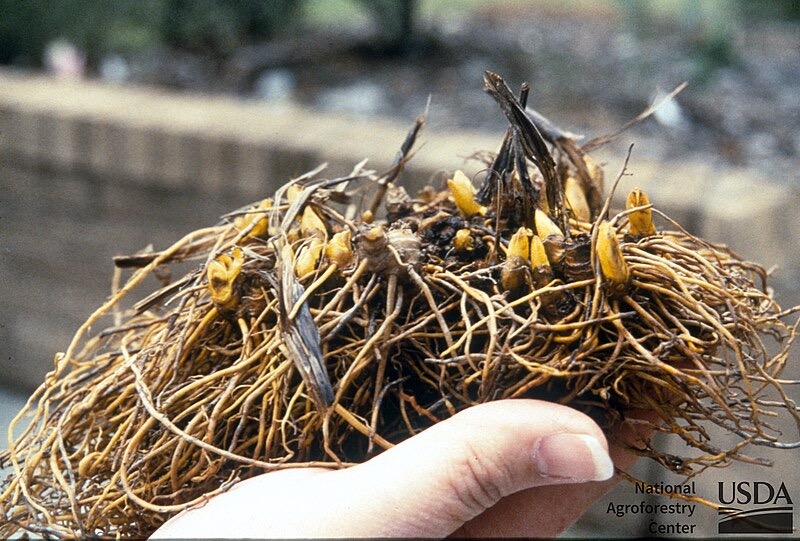 I had an interesting experience using goldenseal and garlic to treat a dental abscess. The dentist couldn't get me in right away and gave me a prescription for an antibiotic to fight the infection until I could get the tooth taken care of. I didn't want to take them because I had been given a lot of antibiotics when I was young due to chronic sinus and respiratory infections. These antibiotics had devastated my gut flora and I had worked hard to restore it to a healthy state and I didn't want to go through that again.
I had an interesting experience using goldenseal and garlic to treat a dental abscess. The dentist couldn't get me in right away and gave me a prescription for an antibiotic to fight the infection until I could get the tooth taken care of. I didn't want to take them because I had been given a lot of antibiotics when I was young due to chronic sinus and respiratory infections. These antibiotics had devastated my gut flora and I had worked hard to restore it to a healthy state and I didn't want to go through that again.
So, I decided to try using garlic and goldenseal instead. I ate one clove of raw garlic and took two capsules of goldenseal every four hours for two days. This protocol worked very well. It rapidly took down the swelling and relieved the pain.
However, an odd thing happened while I was doing this. My sinuses started to drain and I passed some strange mucus. At one point the mucus had a bright orange color to it and at another point a tannish-brown color. In both cases, the mucus smelled moldy with an antibiotic-like aroma. One of my office assistants, who was a registered nurse, said my descriptions sounded like ampicillin and tetracycline, two antibiotics I had been given years ago when I developed a mild case of pneumonia. Had some of these drugs remained in my system all those years?
I’ve heard of people who started eating healthier and using herbal remedies throwing up or passing material in their stool that smelled like medications they’d taken years before, so it’s a possibility that this is exactly what happened. This is part of what has traditionally been called a “healing crisis” where the body finally becomes strong enough to throw off irritants that have been lodged in the tissues because the body wasn’t strong enough to detoxify them.
Toning Tissues with Goldenseal
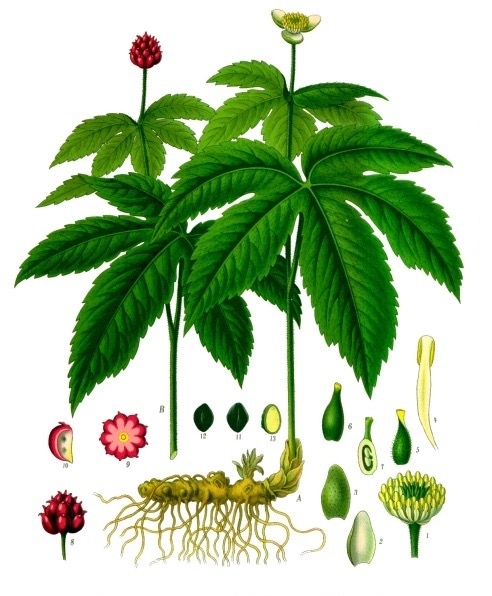 One of the real strengths of goldenseal is its ability to tone up mucus membranes while reducing low-grade or subacute inflammation. This is not due to its berberine content, but rather to an alkaloid called hydrastine, which contracts tissues and stops bleeding. This mildly astringent property in goldenseal is one of the things that differentiates it from other herbs with berberine.
One of the real strengths of goldenseal is its ability to tone up mucus membranes while reducing low-grade or subacute inflammation. This is not due to its berberine content, but rather to an alkaloid called hydrastine, which contracts tissues and stops bleeding. This mildly astringent property in goldenseal is one of the things that differentiates it from other herbs with berberine.
It's hydrastine that makes goldenseal helpful topically for red, irritated eyes when used as an eyewash. In fact, I've heard that hydrastine was once used in over-the-counter eyedrops. I successfully used an herbal eyewash formula containing eyebright, bayberry, and goldenseal to treat myself when I had conjunctivitis. I made a strong tea of this blend and applied it to the eye with cotton balls as a compress.
I've also used goldenseal for sore throats. In this case, I've made a gargle formula using equal parts goldenseal, echinacea, and myrrh gum along with a small pinch of capsicum. You make this as a decoction and gargle with it. The capsicum makes the gargle sting when you first use it, but it also helps numb the pain. If you don't want that effect, however, leave it out.
You could also use the above mixture as a mouthwash. Make an alcohol extract from it and dilute some in warm water to rinse out the mouth. You can also use goldenseal and myrrh gum as a toothpowder for bleeding gums.
Another use for goldenseal is as a remedy for chronic, low-grade sinus infections and nasal polyps. Although you can take it internally, it’s even more effective to make a mixture of goldenseal and bayberry rootbark powders and use it as a snuff or nasal wash. Take a pinch of the powders and snort it up your nose. It will make you sneeze and cause copious drainage, so it’s not the most pleasant treatment, but it’s very effective. You could also make a decoction of the mixture and use it as a nasal wash with either a neti pot or a bulb syringe.
Goldenseal and Blood Sugar
Because of goldenseal's endangered status, I wouldn't recommend using goldenseal to help with blood sugar. If you’re trying to control blood sugar there are plenty of other herbs that are equally, if not more, effective at regulating blood sugar, such as cinnamon, gymnema, nopal, and bitter melon. But it is interesting to note its uses.
LaDean Griffin, author of Is Any Sick Among You? was the first to discover goldenseal has an insulin-like effect, which means it lowers blood sugar. I was aware of this effect for many years and used a number of formulas containing goldenseal to help lower blood sugar, even though most herbal materials didn't even mention this use. However, we now have research showing berberine lowers blood sugar levels, so this may be why it has this effect. An imbalance of intestinal microflora (intestinal dysbiosis) will also cause sugar cravings which goldenseal would help with by balancing the gut microflora. It also helps tone up the mucus membranes counteracting the leaky gut associated with this problem.
Topical Use of Goldenseal
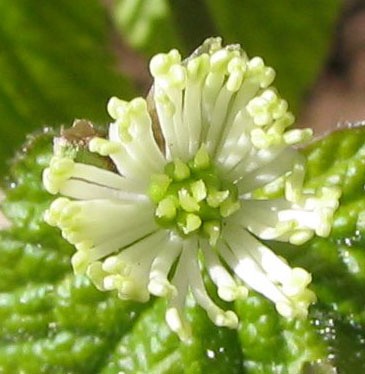 Goldenseal is also helpful when used topically for skin ulcerations or wounds that aren’t healing properly. Matthew Wood, in The Book of Herbal Wisdom, says that goldenseal is a remedy that helps to seal tissues. He uses the tincture topically for “torn disks in the spine, torn meniscus in the knee, torn bursa in the hip, etc.” Because it seals up tissue, it should not be applied to dirty wounds as, according to Matthew, “...it will seal in the “pus, dirt, and infection.” Plantain is better for this purpose.
Goldenseal is also helpful when used topically for skin ulcerations or wounds that aren’t healing properly. Matthew Wood, in The Book of Herbal Wisdom, says that goldenseal is a remedy that helps to seal tissues. He uses the tincture topically for “torn disks in the spine, torn meniscus in the knee, torn bursa in the hip, etc.” Because it seals up tissue, it should not be applied to dirty wounds as, according to Matthew, “...it will seal in the “pus, dirt, and infection.” Plantain is better for this purpose.
If you have an elderly person or a pet who has skin ulcerations sprinkling goldenseal powder over the affected area can aid healing. I’ve used goldenseal topically as part of a poultice mixture for these purposes. I typically combined equal parts marshmallow, slippery elm, and plantain with a smaller amount of goldenseal. You then make this into a paste with a little water or aloe vera gel and apply it topically over the affected area. Poultices should be changed every 4-8 hours.
Another Interesting Experience
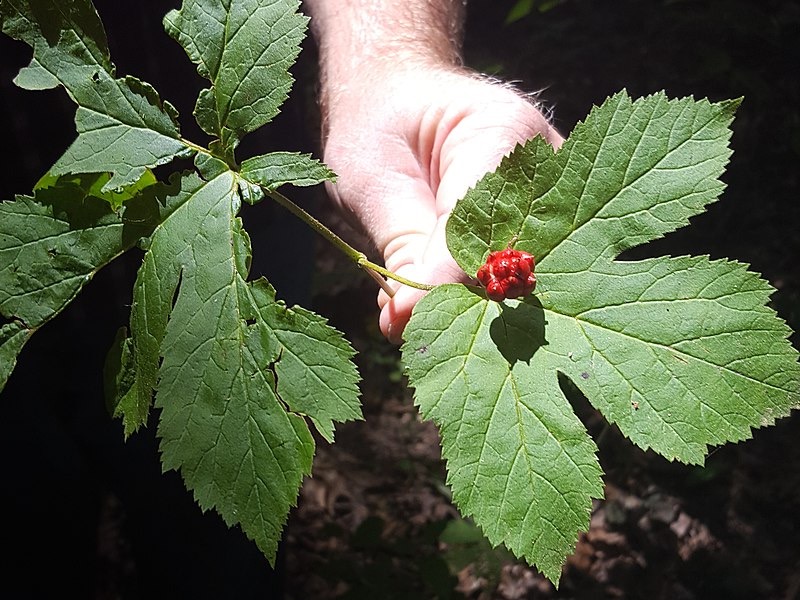 This brings me to another fascinating experience I had using goldenseal. Someone asked me to help her uncle who was losing motor control in his legs. I wasn’t sure if I could be of any help, but as I looked into the situation, I found that he had started to lose motor control after prostate surgery. There was a circular swollen area about three inches in circumference on his back where he had had the spinal block for the surgery. I had the wife apply the poultice mixture mentioned above to his spine every evening when he went to bed. As per my instructions, she put plastic wrap over it and taped it in place so it would work overnight. She then removed it in the morning.
This brings me to another fascinating experience I had using goldenseal. Someone asked me to help her uncle who was losing motor control in his legs. I wasn’t sure if I could be of any help, but as I looked into the situation, I found that he had started to lose motor control after prostate surgery. There was a circular swollen area about three inches in circumference on his back where he had had the spinal block for the surgery. I had the wife apply the poultice mixture mentioned above to his spine every evening when he went to bed. As per my instructions, she put plastic wrap over it and taped it in place so it would work overnight. She then removed it in the morning.
For seven days he woke up feeling nauseous, but on the eighth day, he woke up feeling great. When the poultice was removed the swelling was gone, but in its place was a circle of the same size of an orange-colored substance. She washed it off and from that point on there was no more swelling. Over the next few weeks, he gradually began to regain motor control of his legs.
My hypothesis was that some of the painkillers inserted in his spine for the surgery had lodged in the tissues and began to interfere with nerve function. The poultice drew it out and allowed healing to begin to take place. Here's another example of the controversial "healing crisis" process. Toxins, including drugs, can lodge in the tissues until the body is able to throw them off. How much goldenseal played I role in this process I don’t know, but it’s interesting that in both this experience and the previous one, the common denominator was goldenseal.
Goldenseal Cautions
I wish we hadn't overharvested goldenseal, because you hate losing a valuable herbal ally. Nevertheless, there are some other herbs we could use in its place. For example, yellow root is quite plentiful in the southern states and I've found it to be just as effective as goldenseal for canker sores. It also appears to have a similar toning quality to goldenseal. You can experiment with these other berberine herbs for various conditions, but here are a few uses I still think warrant the use of goldenseal, at least as one part of the therapy: giardia, stubborn sinus infections, and skin ulcerations that won't heal. Hopefully, if more people actively cultivate this herb we can continue to use it for these purposes many years to come.
I would not use goldenseal with autoimmune disorders or with people who have problems with hypoglycemia (low blood sugar). Long-term internal use of goldenseal can result in malabsorption of vitamin B, resulting in fatigue and listlessness, so I would limit its internal use to no more than seven to ten days. It’s also contraindicated in pregnancy (at least in higher doses) because it also contains an alkaloid that stimulates uterine contractions.
Downloads
Steven's Articles
-

-
The Health Benefits and Problems with Coffee
This popular caffeinated beverage can be beneficial…
October
-

-
Understanding Caffeine & Cellular Adaptation
Preserving the power of caffeine's buzz and the…
September
-

-
Horseradish
A pungent spice for aiding protein metabolism…
-

-
Banaba or Crepe Myrtle
A beautiful tree from Southeast Asia whose leaves…
August
-

-
Monkeyflowers
Flower essences to help see ourselves more clearly…
-

-
Mariposa Lilies
Strengthening the bond between mother and child…
-

-
The Noble Bay Leaf
A common kitchen herb for aiding digestion and…
-

-
Epimedium: Horny Goat Weed
A circulatory stimulant and kidney yang tonic…
July
-

-
The Medicinal and Nutritional Benefits of Apricots
A nutritious fruit and valuable medicinal seed for coughs
-

-
Dogwoods
Asian dogwood is used to stop excessive discharge,…
June
-

-
Neem: The Village Pharmacy
A popular Ayurvedic remedy for dental and immune…
-

-
Spilanthes: The Toothache Plant
A traditional remedy for teeth and gums, as well…
-

-
Forsythia
An anti-inflammatory, fever-reducing, and infection fighting herb
May
-

-
Buckwheat (Kashi)
A delicious, high protein, gluten-free, gut-healthy food
-

-
Leaky Gut Syndrome
Plugging the leaks on the underlying cause of…

